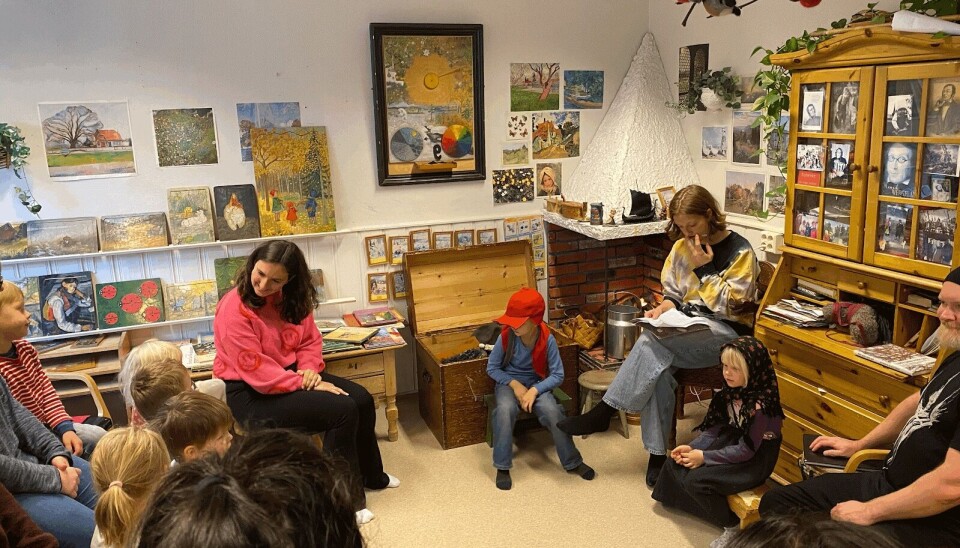
Can a University Course Save the Fairy Tales?
At OsloMet, one professor tries to make sure fairy tales stay relevant for generations to come.
You might have visited souvenir shops filled with Viking-themed items and troll figurines, reminiscent of Marvel’s Thor and the trolls from the Disney movie Frozen. Unknown to many, these figures live hidden lives beyond entertainment. What if I told you that these symbolic figure actually play a deeper role in shaping Norwegian society and education?
Fairy Tales and Nationalisation

— Fairy tales have played a significant role in the building of Norwegian identity, says Torgeir Haugen, a lecturer at OsloMet who teaches a course on the role of fairy tales in early education.
Published in 1841, a collection of Norwegian fairy tales, Norske folkeeventyr, by Peter Christen Asbjørnsen and Jørgen Engebretsen Moe (commonly referred to as Asbjørnsen and Moe) gained prominence after Norway achieved partial independence from Denmark in 1814. The fairy tales were written in the newly developed bokmål, a writing standard that persists to this day. Like bokmål, the stories came to signify the uniqueness of modern Norwegian society.
According to Haugen, these fairy tales play an important role in schools even today, especially in early education. Over the decades, they have served as a bridge between modernity and pre-modernity. He encourages his students to reflect upon the meaning and patterns in these tales.
— The stories provide insight into how our ancestors lived, showcasing the historical context behind each tale, often linked to the nationalization of Norway. Additionally, fairy tales connect generations across both urban and rural communities, he says.
A Tool of Social and Emotional Education

Fairy tales can help children deal with hardship, enabling them to build their identity by modelling themselves after characters in the stories. Haugen states that many fairy tales feature characters with special needs, and so they remain relevant to children who struggle to keep up in the classroom and who are not able to socialize with peers.
— These characters can empower children by allowing them to read into the actions of characters and to practice moral traits like kindness and bravery, he says.
Fairy tales have played a significant role in the building of Norwegian identity.
Torgeir Haugen, lecturer at OsloMet
Drawing from his experience as a therapist, Haugen has used fairy tales to assist in children’s psychological development. His course presents fairy tales as tools for children to address complex emotions in a cathartic way. Haugen shares a case involving two children in kindergarten: one boy who disliked socializing and a hyperactive girl. Neither could blend well into the group of other children around them.
— But when my student read “Ash Lad and the Good Helpers” to the children, she suddenly discovered that the two were sitting still and engaging with the other kids, he attests.
Decline of Fairy Tales
The popularity of these fairy tales, however, is waning. Haugen theorizes that this is partly due to shifting audience perceptions, with some readers interpreting the stories as outdated or even anti-feminist. Take ”The Princess on the Glass Hill” as an example. The three princes trying to win over the princess can be seen as perpetuating patriarchal ideologies, portraying women as dehumanized ‘prizes’ to be claimed by male protagonists.
— In reality, the moral of the story is about kindness and respect and the idea that helping others selflessly may lead to unexpected rewards, Haugen says.
Haugen believes that the historical context of these stories is often overlooked. He argues that greater efforts should be made to understand why a story was written instead of jumping to conclusions without fully comprehending the history behind these tales.
Still in Use
From a young age, we were already expected to know a lot about folk tales.
Wiktoria, Norwegian student
Magnus, a Norwegian student, described how fairy tales were still used in kindergartens and elementary schools during his upbringing. He explained that the frequency of their use varies by school and that the fairy tales chosen are tailored to each age group. Meanwhile Wiktoria, another Norwegian student, recalled the use of Norwegian folklore in her early education.
— From a young age, we were already expected to know a lot about folk tales, she says.
Wiktoria recalls the nationwide culture and arts programme “Den Kulturelle Skolesekken” performing the fairy tale “Den syvende far i huset” at her school. Her class also recreated fairy tales such as “De tre bukkene bruse”. Outside classrooms, the influence of fairy tales can be seen in the many recent live action remakes that explore themes like feminism and identity rights.
Like many Norwegains, Wiktoria recognises “Askeladden”, the iconic Norwegian folk hero. Aged as some of the tales may be, many seem to agree on the positive and prosocial tone of their content.
— Not all stories have a moral, but most fairy tales share the same message with “Askeladden”. They teach readers to help one another, make friends, build connections and live well, she speculates.
































